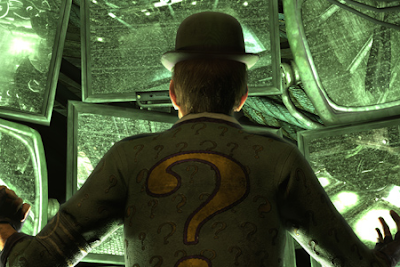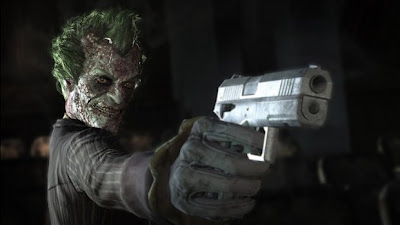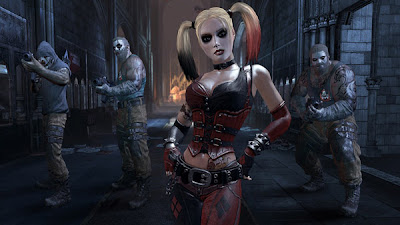The following will contain spoilers for Batman: Arkham City as well as, briefly, The Dark Knight Rises.
I finished Arkham City today – or, at least, finished the main storyline, which is an important distinction in an open-world game.
The ending (the “good end” to the main story, that is), isn’t very satisfying. The lack of satisfaction seems totally intentional, however. Certainly, there is closure. With the exception of Batman’s most recent feature film outing, it’s more closure than we typically get with Batman. The Joker is dead. Hugo Strange, also dead. Ra’s Al Ghul dead-for-now. And yet, Arkham City itself continues to exist after the credits roll. There’s more to be done.
For one thing, the real mastermind in Arkham City is the Riddler. It’s ultimately he who casts the longest shadows over all the proceedings in the game. Climb to a high only reachable at the endgame, and, yet, somehow, there will be a green question mark spraypainted there. How does he do it? Ridder’s challenges are possibly the most self-aware of any collectable in an open-world game. The Riddler himself sometimes lampshades the obstacles he’s put in front of you (“You wonder how I set all this up? … It was easy.”).
The Riddler challenges were extremely well done in the game’s predecessor, Arkham Asylum, and they’re well-done in Arkham City as well. My only complaint about them is that maybe they’re a bit too ubiquitous. What should be a strong story moment can be overshadowed by the background presence of a glowing green trophy. Stop yammering at me, cut-scenes, so I can grab that shiny thing.
That being said, no adversary makes me want to find all a game’s secrets in quite the way the Riddler does. The stakes for finding all the secrets in Arkham City seem realer when there is a face to put to them. I know, of course, the Riddler is wasting my time with his ridiculous challenges. I can tell he delights in it. He is the game designer’s voice, but not just that. The Riddler is The Completionist. He puts a human face on that urge inside any gamer to get “one hundred percent.” It’s a face that I want to repeatedly punch.
Yet I’m probably going to hundred-percent this game. No ending where the Riddler was not defeated could be the true end.
The ending we get gives us the somewhat-striking image of Batman carrying the dead Joker out in his arms. There’s a lot to unpack here. Primarily, Joker dies in honor of Mark Hamill, who stated that this particular game would be his swan song in the role. There’s also, though, a sort of visual homage to one famous cover, implied in the way that Batman carries out Joker’s lifeless body. And, seeing Joker perish on-screen, it’s hard to forget that a real performer actually died during the course of playing that same role. (There is a parallel, there, with Clayface, also. He is primarily interested in the Joker as a role, and it’s the method acting of that role that ultimately becomes his undoing. (Though we don’t know what his ultimate fate is after falling in to the Lazarus Pit of course.))
Talia Al Ghul also seems to die in the end, but no one really cares… least of all Batman. He carries the Joker out, and doesn’t care to go back in to look for the woman he was supposedly there to rescue. This is also not very satisfying. It is, however, perfectly logical. Talia, just as she is in The Dark Knight Rises, here only serves as a distraction from Batman’s real relationships: with the Joker, primarily, and also with Catwoman. Even Talia’s last act of defiance – wearing a tracker when she was taken away by the Joker – is rendered moot almost immediately, since Joker gives away their location the minute Batman gets even somewhat close, and literally begs him to come.
Batman and Joker are always treated as both enemies and counterparts. Arkham City is most egregious, among Batman texts I am familiar with (and fully admitting I’m not familiar with every Batman text), in treating them also as lovers. The Joker makes cutting remarks about their “unresolved sexual tension,” and other sound drops make explicit reference to Batman’s anatomy. And then there is that final voiceover: Joker serenading Batman, sadly and weakly, with an actual love song. (You could pretend that was Harley Quinn’s voicemail if you felt bad about it, but I wouldn’t buy that.)
Batman seems to also have placed value in this relationship. When Joker arrives again, revealing the truth about the Clayface switcheroo, Batman says: “It was never you.” He may as well be saying this about the dying Talia. When Alfred, in an earlier conversation, chides Batman for valuing one person’s life over the lives of all of Gotham, it may very well not be Talia to whom he is referring. Batman values the Joker’s life – for perhaps symbolic, and/or quite literal reasons – above other lives in Gotham. If he didn’t feel that way, he would probably feel better about letting him die, knowing how many people have died because of him.
On the big screen, The Dark Knight Rises is explicit about matching Batman to Catwoman, and, again, brushing Talia aside. The Batman/Catwoman relationship is also a more-satisfying one than the relationship beween Batman and Talia in the game. It continues the will-they/won’t-they game, though it doesn’t give a definitive answer. Arkham City is notable in that it both allows Catwoman the opportunity to reject Batman (causing a bad ending), yet, it also denies her that opportunity (by automatically taking back and rewinding that ending after it’s viewed).
The way the game handles female characters in general has been noted elsewhere. I definitely think that a lot of the goon dialogue toward or regarding female characters, while it seemed “in character” for evil goons, was pretty off-putting (“You’re going to beg me to stop,” says an inmate as he’s beating up Catwoman. This seems to imply other things.). The sexualization of Catwoman is certainly over-the-top, but in a way I can forgive, because it is Catwoman. Most of her takedowns involve gripping guys between her thighs, for example, but, well, Catwoman. The way Harley Quinn is sexed-up, to me, is a little more bizarre. Not because she’s never been a sexy character, but because that’s never really been the point of her character. Who did she get that new outfit for, exactly? Not the Joker – though she’s famously vamped for his interest before, she’s surely aware he’s a little busy dying at the moment. Wait, I know who the outfit is for: the fans. (“She’ll provide me with several minutes of fun,” says the Penguin, letting us guess what sort of fun she will be.)
I’m astonished that the dialog in this game was mild enough for a T rating. Not so much the swears (apparently, developers are allowed as many instances of “bitch” or “ass” as they like in a T rating), but for the actual content. Aside from the sexual threats, Zsasz’s speech about how much fun it is to violently murder people is a real standout here. To wit: loving depictions of violent murder: M rating. Loving descriptions of violent murder: T rating. Arkham City is probably the darkest tone T-rated game I have played. I wouldn’t really call this a complaint, but found it surprising.
I’ve spent this whole time discussing narrative elements, and not particularly touched on ludic elements (aside from Riddler). This is because most of those elements didn’t change too much from the previous Batman game. The experience of being Batman is a great one. The experience of being Catwoman is …close, but an obvious port from the Batman experience. I would imagine being Catwoman “really” to involve a little more stealing-of-things, and a bit less beating-up-Joker’s-thugs. But it works.
There will probably be a third of these games. Even the game seems aware of that possibility (a wandering thug ponders: will it be “Big Old Arkham World next?”). A big question fans seem to have is if the Joker death ending was a fakeout. I think it wasn’t, because, I think it works. Yes, I said it was unsatisfying; it is. But I still think that this is intentional. The second part of a trilogy generally ends on a down note, so this was not an accident. Arkham City did have a much better final confrontation and better bosses all-round, and I’m looking forward to seeing what might be done in a future installment.




Leave a Reply